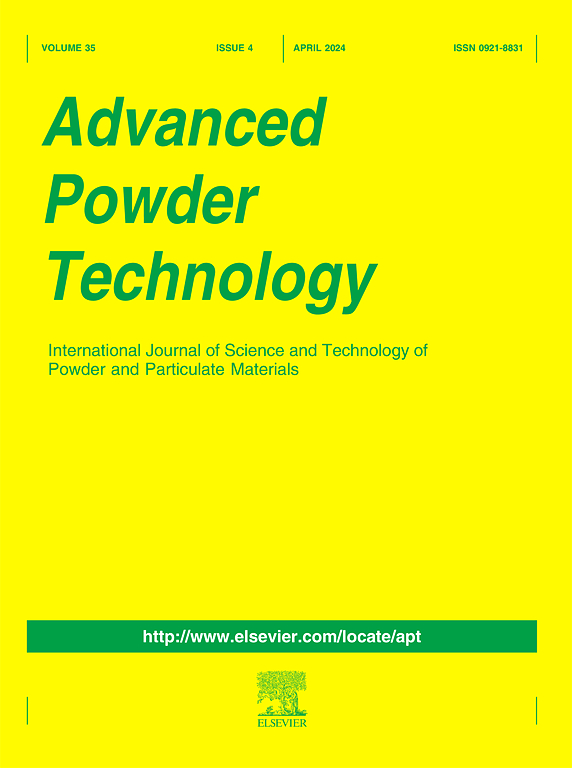Gas and liquid state ammonia boosted in the hydrolysis of secondary aluminum dross
IF 4.2
2区 工程技术
Q2 ENGINEERING, CHEMICAL
引用次数: 0
Abstract
This study elucidates the behavior of gas and liquid state ammonia generation in both short-term and long-term hydrolysis of secondary aluminum dross (SAD) powders, with detailed characterizations of the chemical structure and surface chemical state change of SAD particles during the hydrolysis reaction. Altered aluminum hydroxides, boehmite, bayerite, and gibbsite, were formed selectively on the surface of SAD in prolonged hydrolysis, which play principal roles in the progress of the hydrolysis reaction and generation of gas and liquid state ammonia. The influence of the reaction temperature on the hydrolysis of SAD is also clarified in advance, which demonstrates a distinguished reaction dynamics and mechanism. It was found that the gasification of dissolved liquid state ammonia is a predominant process, instead of a promoted hydrolysis of SAD for enhanced gas state ammonia production. Moreover, a novel and facile approach is introduced for boosting both gas and liquid state ammonia via beads mill-assisted hydrolysis of SAD powders. During beads mill process, the coverage of aluminum hydroxides on SAD was hindered via the mechanical breaking of particle surface. Continuous hydrolysis was then achieved through the further promoted reaction between water and the exposed new surface of SAD, which significantly enhances ammonia generation.

铝渣水解过程中气液两态氨的增加
本研究阐明了二次铝渣(SAD)粉末在短期和长期水解过程中气态和液态氨的生成行为,详细表征了二次铝渣(SAD)颗粒在水解反应过程中的化学结构和表面化学状态变化。在长时间的水解过程中,在SAD表面选择性地形成了改变的氢氧化铝、薄水铝石、白铝石和三水铝石,它们在水解反应的进行和气液氨的生成中起主要作用。研究了反应温度对SAD水解的影响,揭示了不同的反应动力学和反应机理。研究发现,溶解液态氨的气化是主要的过程,而不是促进SAD水解以提高气态氨的产量。此外,还介绍了一种新的、简便的方法,通过珠磨辅助水解SAD粉末来提高气态和液态氨。在球磨过程中,由于颗粒表面的机械破碎,阻碍了氢氧化铝在SAD上的覆盖。然后通过进一步促进水与暴露的SAD新表面之间的反应实现连续水解,从而显著增强氨的生成。
本文章由计算机程序翻译,如有差异,请以英文原文为准。
求助全文
约1分钟内获得全文
求助全文
来源期刊

Advanced Powder Technology
工程技术-工程:化工
CiteScore
9.50
自引率
7.70%
发文量
424
审稿时长
55 days
期刊介绍:
The aim of Advanced Powder Technology is to meet the demand for an international journal that integrates all aspects of science and technology research on powder and particulate materials. The journal fulfills this purpose by publishing original research papers, rapid communications, reviews, and translated articles by prominent researchers worldwide.
The editorial work of Advanced Powder Technology, which was founded as the International Journal of the Society of Powder Technology, Japan, is now shared by distinguished board members, who operate in a unique framework designed to respond to the increasing global demand for articles on not only powder and particles, but also on various materials produced from them.
Advanced Powder Technology covers various areas, but a discussion of powder and particles is required in articles. Topics include: Production of powder and particulate materials in gases and liquids(nanoparticles, fine ceramics, pharmaceuticals, novel functional materials, etc.); Aerosol and colloidal processing; Powder and particle characterization; Dynamics and phenomena; Calculation and simulation (CFD, DEM, Monte Carlo method, population balance, etc.); Measurement and control of powder processes; Particle modification; Comminution; Powder handling and operations (storage, transport, granulation, separation, fluidization, etc.)
 求助内容:
求助内容: 应助结果提醒方式:
应助结果提醒方式:


